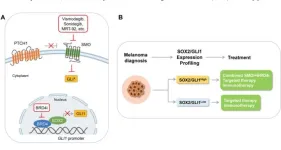(Press-News.org) New Haven, Conn. — Decades after Purdue Pharma began to push physicians to prescribe addictive pain pills, the opioid crisis has been a slow-motion disaster, with overdoses destroying lives and families across the country.
Now, it appears the consequences of those early marketing efforts are even more devastating. In a new study, researchers at the Yale School of Public Health show that infectious disease rates in the United States also climbed as a direct long-term result of the marketing of OxyContin.
By comparing U.S. states that saw heavier OxyContin promotion with states that experienced less, the Yale study shows for the first time that this marketing caused long-term rises not only in overdose deaths but also in hepatitis diagnoses and deaths from infective endocarditis, a bacterial infection in the heart. This occurred after 2010, when many people with addiction to pills began to use intravenous opioids instead, running the risk of spreading infections through contaminated needles.
“The most shocking finding is that we're still seeing the ramifications of marketing decisions from 25 years ago,” said first author Julia Dennett, a postdoctoral associate in the YSPH Department of Epidemiology of Microbial Diseases.
The findings appear on July 19 in the journal Health Affairs.
Reformulation spurs illicit drug use
In the mid-1990s, Purdue Pharma began to target physicians in some states with an aggressive marketing campaign for its potent opioid pain pill OxyContin.
Pharmaceutical representatives offered free meals, swag, and conference trips alongside a pitch that aimed to convince prescribers — particularly those who treated cancer patients — that the drug was also safe and appropriate for non-cancer pain, such as chronic back pain.
“There was a lot of misleading information in the advertising materials,” Dennett said. “They very much downplayed the risks of addiction.”
In 2010, amid growing evidence that the pills were indeed addictive and that they were often diverted and misused, Purdue reformulated OxyContin to make it harder to crush and snort. As a result, studies have found, many people with an addiction to opioid pills turned to substitute opioids in the form of intravenous heroin or fentanyl.
Intravenous drug use can spread bloodborne infections, including hepatitis and HIV. Knowing this, the researchers investigated whether states targeted for more OxyContin marketing saw more injection drug-related infections, too.
Targeted marketing
Other scientists had already found that Purdue’s 1990s-era marketing push led to worse long-term health outcomes. They did so by examining differences in areas targeted by Purdue Pharma for more OxyContin marketing versus those that received less marketing investment. Areas with higher cancer rates and/or states where less paperwork was required for prescriptions received far more attention from the company.
One study demonstrated that areas with higher cancer rates later saw higher rates of death related to opioid use, even though prior to OxyContin, both high- and low-cancer areas had similar rates of opioid deaths.
Another study examined five states that required doctors prescribing opioids to complete extensive paperwork called triplicate prescribing. In these states, the researchers found, the company shied away from aggressive marketing efforts, fewer OxyContin prescriptions were written, and fewer overdose deaths occurred.
Comparative analysis
To determine whether OxyContin marketing influenced later rates of infectious disease related to substance use, the Yale team compared post-2010 injection drug use-related outcomes in states that had seen more OxyContin marketing years earlier with those that received less.
The authors compared states with a higher cancer burden against those with lower cancer rates and states requiring less prescription paperwork with those requiring more documentation. Using these distinctions, they divided states into high-, middle-, and low-marketing exposure categories. States with either triplicate prescribing or low cancer rates experienced less OxyContin marketing and served as controls.
The outcomes of interest were new infections with viral hepatitis A, B, or C, or HIV, as well as deaths related to endocarditis, a dangerous infection of the heart valves that is often related to injection drug use. The authors also examined death rates related to synthetic opioid overdose or heroin overdose.
A dramatic divergence
Prior to the reformulation of OxyContin, the authors found, rates of infections spread by intravenous drug use as well as illicit overdose deaths were similar in high- and low-marketing exposure states.
After the reformulation, however, those rates diverged. Years after initial OxyContin marketing, there was more infectious disease related to intravenous drug use in states that had been exposed to more marketing, compared to states that had received less, the researchers said.
Specifically, from reformulation in 2010 until 2020, per 100,000 residents, high-exposure states saw, on average, an additional 0.85 acute hepatitis B cases, 0.83 hepatitis C cases, and 0.62 cases of death from infective endocarditis. In addition, high-exposure states had 5.3 more deaths per 100,000 people from synthetic opioid overdose.
“Prior to 2010, among these states, there were generally no statistically significant differences in these outcomes. After 2010, you saw them diverge dramatically,” Dennett said.
Limitations of the research include limited available data on pre-2010 HIV rates and a lack of access to company marketing data. The authors were also not able to take into account all post-2010 changes in state policies that could have affected outcomes.
Regulatory controls needed
Dennett said regulatory systems need to take steps to prevent similar crises in the future, such as limiting the ability of the pharmaceutical industry to promote drugs to physicians or influence regulatory bodies.
Meanwhile, she said, it’s crucial to ensure more support for communities harmed by their exposure to long-ago OxyContin marketing.
“Policymakers can promote harm-reduction services to try to reduce the spread of infectious disease and reduce overdoses, and they can also take steps to expand access to treatment for opioid use disorder,” Dennett said.
The research was funded by the National Institute on Drug Abuse of the National Institutes of Health under award numbers DP2DA049282 and R37DA15612. The content is solely the responsibility of the authors and does not necessarily represent the official views of the National Institutes of Health.
Gregg Gonsalves, associate professor of epidemiology (microbial diseases) at the Yale School of Public Health, is co-author.
END
Hepatitis cases and heart valve infection deaths tied to early OxyContin marketing
2023-07-19
ELSE PRESS RELEASES FROM THIS DATE:
Treatment at the first signs of MS could mean lower risk of disability later
2023-07-19
EMBARGOED FOR RELEASE UNTIL 4 P.M. ET, WEDNESDAY, JULY 19, 2023
MINNEAPOLIS – People who start taking medication soon after the first signs of multiple sclerosis (MS) may have a lower risk of disability later, according to a study published in the July 19, 2023, online issue of Neurology®, the medical journal of the American Academy of Neurology.
MS is a disease in which the body’s immune system attacks myelin, the fatty white substance that insulates and protects the nerves. Symptoms of MS may include fatigue, numbness, ...
Teaching robots to teach other robots
2023-07-19
You’re a poker wizard. A friend knows all about French cuisine. Another friend is a Mozart expert.
The three of you get together and share knowledge about your respective expertise. Each of you leaves learning something from the other two.
People learn a lot by sharing and exchanging information. Can computers do the same with other computers—can robots, in effect, teach other robots how to learn by sharing knowledge?
A team of researchers led by computer science Professor Laurent Itti and one of his Ph.D. students, Yunhao Ge, address this question in ...
Molecular biologists identify framework for understanding RNA editing in a disease-causing parasite
2023-07-19
As molecular biologists at Boston University and as husband and wife, Ruslan Afasizhev and Inna Afasizheva, have worked together for decades. Together, they have published dozens of papers on the mechanics of mitochondrial DNA and RNA in a single-celled, disease-causing parasite called Trypanosoma brucei. Now, years of breakthroughs have led to their latest paper published in Science, which provides a detailed look at a mystifying process called RNA editing and could potentially help treat a deadly disease.
In ...
Picturing where wildlands and people meet at a global scale
2023-07-19
Researchers led by a team at the University of Wisconsin–Madison have created the first tool to map and visualize the areas where human settlements and nature meet on a global scale. The tool, which was part of a study recently published in Nature, could improve responses to environmental conflicts like wildfires, the spread of zoonotic diseases and loss of ecosystem biodiversity.
These areas where people and wildlands meet are called the wildland-urban interface, or WUI for short. More technically, a WUI (pronounced “woo-ee”) describes anywhere that has at least one house per 40 acres and is also 50% covered by wildland ...
Using new method, study highlights physician turnover trend
2023-07-19
Using an innovative method for measuring doctor turnover, Weill Cornell Medicine researchers determined that between 2010 and 2018, the annual rate at which physicians left their practices increased by 43 percent, from 5.3 percent to 7.6 percent a year. The causes of this trend are not known, but warrant further investigation, according to the researchers.
The study, published July 11 in the Annals of Internal Medicine, also found that the first three quarters of 2020 (the start of the COVID-19 pandemic in the United States) were not associated with higher turnover. However, more data are needed to fully understand turnover trends related to COVID-19.
Whether doctors ...
Winery experiences affected by more than what is in your glass
2023-07-19
New research from the University of British Columbia's Okanagan campus has determined that enjoying a tasting at a winery goes well beyond the sip.
Professor Annamma Joy, with UBCO’s Faculty of Management, conducts research in the area of consumer behaviour and branding with a special focus on luxury brands, fashion brand experiences, wineries and wine tourism.
Dr. Joy, along with her collaborators and students, studied several Okanagan wineries over a three-year period to comprehensively document the experiences ...
Researchers use mass spectrometry to explore antimicrobial resistance
2023-07-19
Laura-Isobel McCall, Ph.D., and Zhibo Yang, Ph.D., co-principal investigators and associate professors of chemistry and biochemistry in the Dodge Family College of Arts and Sciences at the University of Oklahoma, have been awarded a prestigious R01 grant from the National Institutes of Health for their project, “Novel single-cell mass spectrometry to assess the role of intracellular drug concentration and metabolism in antimicrobial treatment failure.”
“Our project builds upon Dr. ...
Novel therapeutic strategy against melanoma: combined targeting of hedgehog signaling and BRD4
2023-07-19
“This evidence strengthens the relevance of the findings by Pietrobono et al., shedding light on the potential application of SMO inhibitors in concert with BRD4 inhibitors.”
BUFFALO, NY- July 19, 2023 – A new editorial paper was published in Oncotarget's Volume 14 on May 26, 2023, entitled, “Combined targeting of HEDGEHOG signaling and BRD4 as a novel therapeutic option against melanoma.”
The Hedgehog-GLI (HH/GLI) pathway is aberrantly activated in several types of cancer. Canonical HH/ GLI pathway is triggered by binding of HH ligands to the twelve-pass transmembrane receptor Patched 1 (PTCH1), which retrieves its inhibition ...
Large study finds small associations between systemic inflammation and later dementia
2023-07-19
A study of data from about 500,000 people in the UK Biobank has uncovered small but statistically significant associations between signs of systemic inflammation and later risk of dementia. Dr. Krisztina Mekli of The University of Manchester, UK, and colleagues present these findings in the open-access journal PLOS ONE on July 19, 2023.
Millions of people around the world have Alzheimer’s disease or other types of dementia, and researchers are working to tease out the complex mechanisms behind these conditions. Prior research has suggested that inflammation—activation of the body’s innate immune system—may ...
STEM instructors who are women drive disclosure of concealable stigmatized identities to undergraduates
2023-07-19
Women working as STEM instructors are more likely than men in the same profession to disclose to their undergraduate students identities which could carry stigma, such as depression or growing up in a low-income household. In the new study, published July 19, 2023 in the open-access journal PLOS ONE, Carly Busch of Arizona State University, USA, and colleagues suggest that these decisions to disclose may be in order to act as role models for students.
Concealable stigmatized identities (CSIs) are identities that ...






